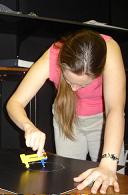My former colleague Dr Catherine O’Hanlon, now at Aberystwyth, and I have just published a paper on an interesting effect we found in small children. The roots of this study go back 7 years to when my son was two and I was reading a picture book with him. I was asking him to find various colours, and I noticed that he struggled to find colours that were in the background of the picture, like “blue” in a seascape or “yellow” in a beach scene. Apparently, he automatically ignored the background and attended only to colours in foreground objects. I thought that was an interesting phenomenon, and asked my developmental-psychology colleague Catherine if this was well known in small children. She said it hadn’t been reported, so we went ahead and tested more children to see if it was just my offspring or more widespread. It turns out that many two- and three-year-olds show this effect. They seem to assume that you must be talking about objects, even when you ask them something neutral like “Can you find green?”.
We think this bias helps young children acquire language.
Here are links to the press release and the paper itself.




















